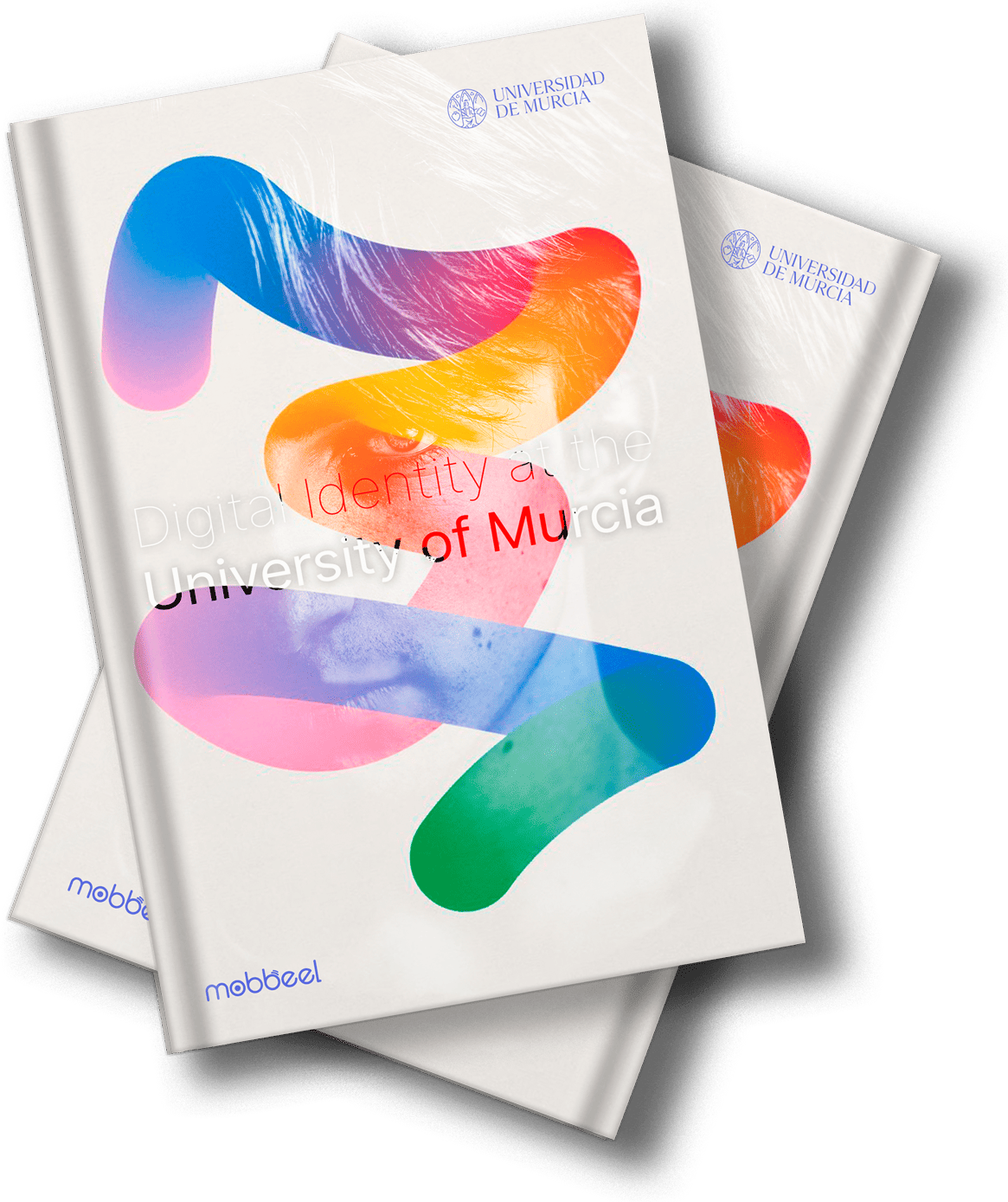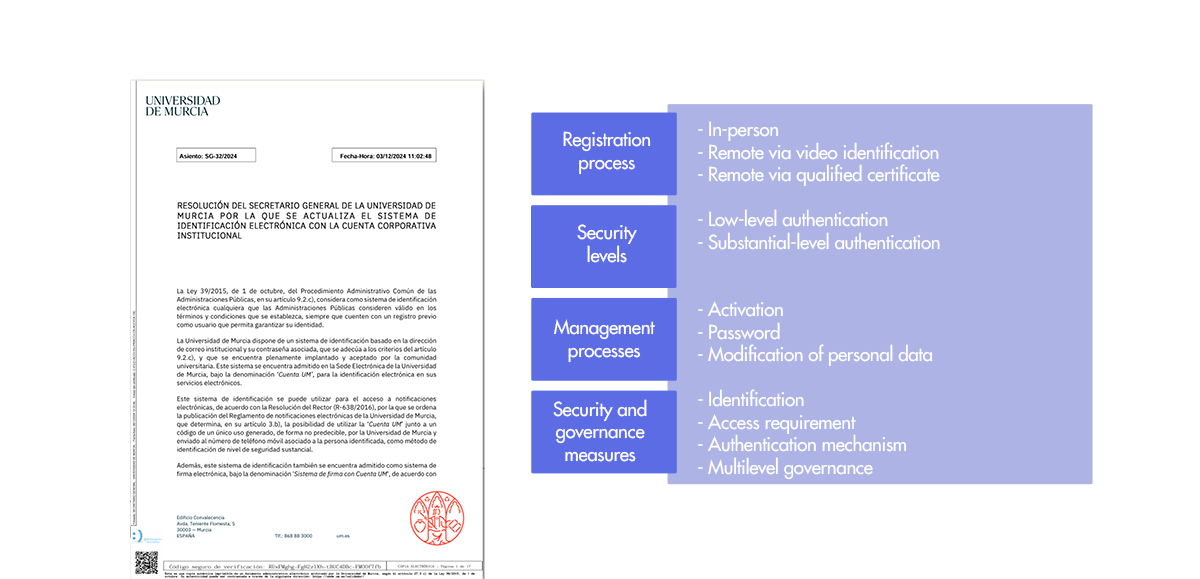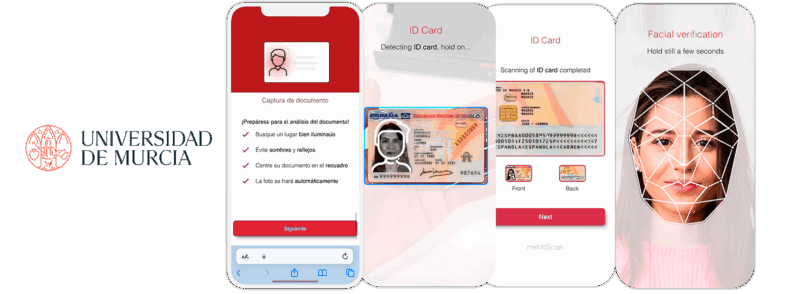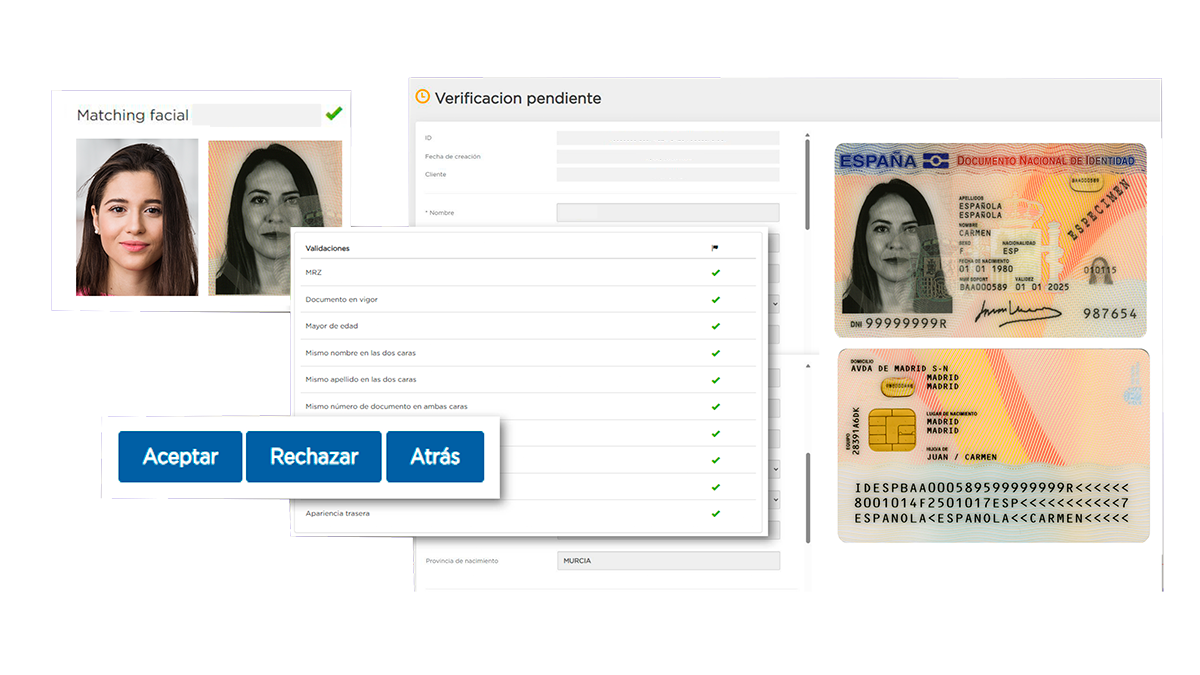
Digital identity at the University of Murcia
The beginning of any relationship between a university and its users whether students, staff, or collaborators requires precise and secure verification to ensure data protection and the integrity of its systems.
In this context, the digital onboarding project at the University of Murcia emerges as a pioneering solution aligned with the sector’s best practices, offering a digital identity model for the university that combines the agility of remote identification with strict compliance with the highest regulatory and security standards.
Index
Origin and initial situation
The University of Murcia, like many academic institutions, had a traditional system for digital identity verification and user registration based on passwords and one-time codes. This model required users to go to the university in person to complete the necessary procedures to obtain their access credentials.
Nevertheless, this in-person procedure had significant drawbacks, which became more evident due to two key factors that highlighted the need for transformation:
- The COVID-19 pandemic, which forced a reduction in on-site activity at the university and underscored the need for remote registration and identity verification procedures.
- Having to go to the university campus in person just to complete the registration process was particularly inconvenient, especially for distance learning students or those enrolled in short-term courses who otherwise have little interaction with the university.
These challenges drove the creation of a new project within the university’s 2025 ITC project portfolio, aimed at developing a digital onboarding system that would enable remote user registration in a secure manner and with the same guarantees as in-person verification.

Importance of the new regulation
One of the major milestones that enabled the implementation of the digital onboarding project at the University of Murcia was the update of the internal regulations governing the university’s electronic identification system. Until then, identification processes were limited to in-person methods and did not include remote mechanisms, which posed an obstacle to advancing the digitalization of university services.
With the publication of Resolution SG-30/2024, the university incorporated video identification as a valid user registration method. This resolution expanded the previous framework by recognizing remote registration via video identification as a valid identification mechanism.
Furthermore, the regulation addressed key aspects to ensure the security and governance of the process, such as:
-
Authentication levels (low and substantial).
-
Processes for account activation, password management, modification of personal data, and account deactivation.
-
Access requirements and multilevel security and governance measures.
This regulatory update was essential to legitimize the implementation of video identification, ensuring that remote procedures offered the same level of reliability and security as in-person ones.

Solution: Digital Onboarding
To tackle the issue of remote registration and user digital identity verification, the University of Murcia conducted a selection process for a provider. This process concluded with the selection of MobbScan, a digital onboarding solution developed by Mobbeel. This technology was chosen to meet the need for a tool that adheres to the highest standards of security, reliability, and usability. Additionally, it integrates seamlessly with the university’s electronic headquarters and complies with Spanish and European data protection regulations.
MobbScan is certified at the high level according to the National Security Framework (ENS) and has been entirely designed by Mobbeel, ensuring full control over the technology and customization capacity to fit the university’s specific use cases. Among its main features are:
- Validation of national and international identity documents (DNI, NIE, passport).
- Facial biometrics to ensure the match between the user and the document image.
- Artificial intelligence to detect fraud or impersonation attempts.
- Web portal that allows manual review and validation of processes when required.
The integration of MobbScan into the University of Murcia’s electronic headquarters was a key step in ensuring a smooth and accessible user experience. Users can start the onboarding process directly from the enabled procedures, without the need to travel and with all the necessary legal and technical guarantees.
The choice of MobbScan and its successful integration reflect the university’s commitment to technologically advanced solutions with the highest security standards.
Digital Onboarding journey
The video identification technology implemented through MobbScan allows the University of Murcia to carry out remote user registration with the highest guarantees of security and reliability. The process is integrated directly into the university’s electronic headquarters and consists of several phases that ensure both proper user identification and the validity of the information provided.
The workflow is as follows:
-
- Access to the service: The user accesses the digital onboarding procedure from the electronic headquarters and accepts the terms of use of the service.
- Verification of basic data: The system requests the user’s email address and mobile phone number, which are verified through confirmation codes.
- selection and capture of documents: The user selects the type of document to be used (DNI, NIE, or passport) and captures images of it, first on the front side and then on the back.
- Video selfie and liveness check: The system asks the user to record a short video and take a selfie. Facial biometric technology then verifies the match between the captured image and the photo on the identity document, ensuring the user’s authenticity.
- Automatic verification: The MobbScan solution performs a set of automatic checks, such as matching data on the front and back of the document, image clarity, and biometric match.

- Three possible outcomes:
- Successful automatic validation: The process is completed, and access credentials are created for the user.
- Manual review by an agent: If the result falls within a doubtful range, an authorized agent manually reviews the collected evidence.
- Automatic rejection: If the system determines that the minimum reliability thresholds are not met, the process is rejected.
- Account activation: In the case of successful validation, the user receives an email with a link to activate their account for access to university services.


KPI and achieved outcomes
Download the full success story in PDF format and learn about the project’s key indicators.
KPI and achieved outcomes
Download the full success story in PDF format and learn about the project’s key indicators.
Privacy, data protection, and best practices
From the beginning of the project, the University of Murcia has placed special emphasis on ensuring the privacy and protection of the personal data of users involved in the digital onboarding process. To this end, the university has worked in coordination with the General Secretariat and the Data Protection Officer, ensuring that each phase of the project complies with the highest legal and security standards.
One of the main instruments of this protection strategy has been the implementation of a Data Protection Impact Assessment (DPIA), which has made it possible to:
-
Analyze the lawfulness and proportionality of processing biometric and personal data.
-
Confirm that the use of biometrics for remote verification was the method that best-guaranteed equivalence to in-person presence, ensuring the legitimacy of the processing.
-
Verify that there was always an appropriate legal basis: the user’s explicit consent or the existence of alternative methods, such as the use of electronic certificates or the possibility of appearing in person at the university.
-
Review the risk levels and the technical and organizational measures implemented to mitigate such risks.
The university has also taken into account best practices outlined in regulations and sectoral recommendations, such as those of the National Security Framework (ENS) or those issued by competent authorities on digital identity and data protection. As a result, the digital onboarding solution relies on a certified provider (Mobbeel) that complies with recognized security standards, such as the high level of the ENS.
In addition, measures have been taken to ensure multilevel governance and transparency in data processing, providing users with effective control over their information and rights.
This combination of legal, organizational, and technological measures reinforces trust in the digital onboarding system and ensures compliance with the highest standards of privacy and security required for a remote identification solution in the university environment.
Overview of the services using our digital identity solution, including roadmap and future applications at the university
Currently, the digital onboarding solution implemented through MobbScan is being used in several key university processes, enabling remote identity verification and the fully digital generation of access credentials. The main current use cases are:
-
Enrollment of high school students with special needs for university entrance exams, in collaboration with educational counselors from the Region of Murcia.
-
Registration for exams and language courses, including English, French, and German, among others, for individuals with occasional ties to the university.
-
Enrollment in official and proprietary master’s and doctoral programs, especially in online master’s programs, where in-person verification would pose a barrier to participation.
Additionally, the planned roadmap for the coming months includes extending the use of video identification technology to other processes, notably:
-
Admission via transcript transfer for students from other universities wishing to join the University of Murcia.
-
Spanish courses for foreigners, anticipating increased enrollment of international students with a passport or NIE.
-
Doctoral enrollment and expansion to more master’s programs in the second and third enrollment phases are planned for the 2025/26 academic year.
The university has also identified future possibilities for using video identification technology beyond initial user registration. These include:
-
Credential recovery for users who have lost their usual access methods, such as a mobile phone or electronic certificate.
-
Updating older accounts that were created without complete security information, thus strengthening data reliability and security.
-
Occasional revalidation of identity in specific situations requiring additional assurance that the submitted data matches the account holder.
These possibilities demonstrate that the implemented technology not only addresses the need to register new users remotely but also opens the door to a more secure, flexible digital identity and credential management model that is better suited to the university’s evolving needs.
High social impact
At Mobbeel, we understand that technology should not only address technical or business needs but also contribute to the well-being of society. The digital onboarding project developed in collaboration with the University of Murcia is a clear example of how innovation can make people’s lives easier and create a positive impact beyond the boundaries of an organization.
Our video identification solution allows students, professionals, and citizens to access university services quickly and securely, eliminating geographical barriers and reducing the need for in-person procedures. This not only represents progress in terms of efficiency and convenience but also expands educational and personal development opportunities for groups that may have previously faced difficulties accessing these resources.
The University of Murcia’s commitment to responsible digitalization and its trust in MobbScan strengthens our dedication to creating solutions that improve people’s lives and enhance the relationship between institutions and society.
Our team continues to work to ensure that technology remains a driving force for progress, change, accessibility, and inclusion.

Download the full University of Murcia success story in PDF format.
Discover how the University of Murcia has transformed its user verification process with the most advanced and secure video identification technology. Download our full success story now and learn how to improve your users’ experience with complete security and regulatory compliance.

What will you find in this success story?
- How the regulatory update enabled the implementation of video identification.
- The implemented solution and why Mobbeel was chosen as their technology partner.
- Services are already using this technology and the university roadmap for its progressive rollout.
- The importance of privacy and how the university and Mobbeel worked together to meet data protection and governance requirements.
- And as a bonus: the most relevant KPIs obtained in the first months of use and how this data is helping the university plan the system’s expansion.
